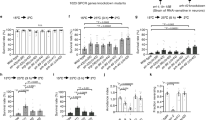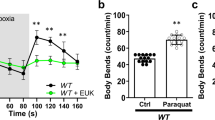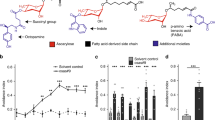Abstract
Specialized oxygen-sensing cells in the nervous system generate rapid behavioural responses to oxygen. We show here that the nematode Caenorhabditis elegans exhibits a strong behavioural preference for 5–12% oxygen, avoiding higher and lower oxygen levels. 3′,5′-cyclic guanosine monophosphate (cGMP) is a common second messenger in sensory transduction and is implicated in oxygen sensation. Avoidance of high oxygen levels by C. elegans requires the sensory cGMP-gated channel tax-2/tax-4 and a specific soluble guanylate cyclase homologue, gcy-35. The GCY-35 haem domain binds molecular oxygen, unlike the haem domains of classical nitric-oxide-regulated guanylate cyclases. GCY-35 and TAX-4 mediate oxygen sensation in four sensory neurons that control a naturally polymorphic social feeding behaviour in C. elegans. Social feeding and related behaviours occur only when oxygen exceeds C. elegans' preferred level, and require gcy-35 activity. Our results suggest that GCY-35 is regulated by molecular oxygen, and that social feeding can be a behavioural strategy for responding to hyperoxic environments.
This is a preview of subscription content, access via your institution
Access options
Subscribe to this journal
Receive 51 print issues and online access
$199.00 per year
only $3.90 per issue
Buy this article
- Purchase on Springer Link
- Instant access to full article PDF
Prices may be subject to local taxes which are calculated during checkout





Similar content being viewed by others
References
Wu, R. S. Hypoxia: from molecular responses to ecosystem responses. Mar. Pollut. Bull. 45, 35–45 (2002)
Wannamaker, C. M. & Rice, J. A. Effects of hypoxia on movements and behavior of selected estuarine organisms from the southeastern United States. J. Exp. Mar. Biol. Ecol. 249, 145–163 (2000)
Sylvia, D. M., Fuhrmann, J. J., Hartel, P. G. & Zuberer, D. A. Principles and Applications of Soil Microbiology (Prentice Hall, Upper Saddle River, New Jersey, 1998)
Semenza, G. L. HIF-1: mediator of physiological and pathophysiological responses to hypoxia. J. Appl. Physiol. 88, 1474–1480 (2000)
Lopez-Barneo, J. Oxygen and glucose sensing by carotid body glomus cells. Curr. Opin. Neurobiol. 13, 493–499 (2003)
Duffy, D. C., McDonald, J. C., Schueller, O. J. A. & Whitesides, G. M. Rapid prototyping of microfluidic systems in poly(dimethylsiloxane). Anal. Chem. 70, 4974–4984 (1998)
Dusenbery, D. B. Appetitive response of the nematode Caenorhabditis elegans to oxygen. J. Comp. Physiol. 136, 333–336 (1980)
Wingrove, J. A. & O'Farrell, P. H. Nitric oxide contributes to behavioral, cellular, and developmental responses to low oxygen in Drosophila. Cell 98, 105–114 (1999)
Hou, S. et al. Myoglobin-like aerotaxis transducers in Archaea and Bacteria. Nature 403, 540–544 (2000)
Jain, R. & Chan, M. K. Mechanisms of ligand discrimination by heme proteins. J. Biol. Inorg. Chem. 8, 1–11 (2003)
Yu, S., Avery, L., Baude, E. & Garbers, D. L. Guanylyl cyclase expression in specific sensory neurons: a new family of chemosensory receptors. Proc. Natl Acad. Sci. USA 94, 3384–3387 (1997)
Morton, D. B., Hudson, M. L., Waters, E. & O'Shea, M. Soluble guanylyl cyclases in Caenorhabditis elegans: NO is not the answer. Curr. Biol. 9, R546–R547 (1999)
Morton, D. B. Invertebrates yield a plethora of atypical guanylyl cyclases. Mol. Neurobiol. 29, 97–116 (2004)
Finn, J. T., Grunwald, M. E. & Yau, K. W. Cyclic nucleotide-gated ion channels: an extended family with diverse functions. Annu. Rev. Physiol. 58, 395–426 (1996)
Coburn, C. M. & Bargmann, C. I. A putative cyclic nucleotide-gated channel is required for sensory development and function in C. elegans. Neuron 17, 695–706 (1996)
Komatsu, H., Mori, I., Rhee, J. S., Aiakie, N. & Ohshima, Y. Mutations in a cyclic nucleotide-gated channel lead to abnormal thermosensation and chemosensation in C. elegans. Neuron 17, 707–718 (1996)
Zhao, Y. & Marletta, M. A. Localization of the heme binding region in soluble guanylate cyclase. Biochemistry 36, 15959–15964 (1997)
Coates, J. C. & de Bono, M. Antagonistic pathways in neurons exposed to body fluid regulate social feeding in Caenorhabditis elegans. Nature 419, 925–929 (2002)
de Bono, M. & Bargmann, C. I. Natural variation in a neuropeptide Y receptor homolog modifies social behavior and food response in C. elegans. Cell 94, 679–689 (1998)
Rogers, C. et al. Inhibition of Caenorhabditis elegans social feeding by FMRFamide-related peptide activation of NPR-1. Nature Neurosci. 6, 1178–1185 (2003)
de Bono, M., Tobin, D. M., Davis, M. W., Avery, L. & Bargmann, C. I. Social feeding in Caenorhabditis elegans is induced by neurons that detect aversive stimuli. Nature 419, 899–903 (2002)
Cheung, B. H. H., Arellano-Carbajal, F., Rybicki, I. & de Bono, M. Soluble guanylate cyclases act in neurons exposed to the body fluid to promote C. elegans aggregation behaviour. Curr. Biol. (in the press)
Malinski, T. & Taha, Z. Nitric oxide release from a single cell measured in situ by a porphyrinic-based microsensor. Nature 358, 676–678 (1992)
Malinski, T., Taha, Z. & Grunfeld, S. Diffusion of nitric oxide in the aorta wall monitored in situ by porphyrinic microsensors. Biochem. Biophys. Res. Commun. 193, 1076–1082 (1993)
Karow, D. S. et al. Spectroscopic characterization of the sGC-like heme domains from Vibrio cholerae and Thermoanaerobacter tengcongensis. Biochemistry (in the press)
White, J., Southgate, E., Thomson, J. N. & Brenner, S. The structure of the nervous system of the nematode Caenorhabditis elegans. Phil. Trans. R. Soc. Lond. B 314, 1–340 (1986)
Van Voorhies, W. A. & Ward, S. Broad oxygen tolerance in the nematode Caenorhabditis elegans. J. Exp. Biol. 203, 2467–2478 (2000)
Anderson, G. L. & Dusenbery, D. B. Critical oxygen tension of Caenorhabditis elegans. J. Nematol. 9, 253–254 (1977)
Imlay, J. A. Pathways of oxidative damage. Annu. Rev. Microbiol. 57, 395–418 (2003)
Barak, R., Nur, I., Okon, Y. & Henis, Y. Aerotactic response of Azospirillum brasilense. J. Bacteriol. 152, 643–649 (1982)
Hieb, W. F., Stokstad, E. L. & Rothstein, M. Heme requirement for reproduction of a free-living nematode. Science 168, 143–144 (1970)
Stone, J. R. & Marletta, M. A. Soluble guanylate cyclase from bovine lung: activation with nitric oxide and carbon monoxide and spectral characterization of the ferrous and rerric States. Biochemistry 33, 5636–5640 (1994)
Di Iorio, E. E. in Hemoglobins (eds Antonini, E., Rossi-Bernardi, L. & Chiancone, E.) 57–71 (Academic, New York, 1981)
Acknowledgements
We thank J. Feldman for discussions and contributions to the aerotaxis assay, M. Hudson and D. Morton for advice and discussions, C. Ross, S. Nicholls and M. Miazgowicz for technical assistance, M. Zimmer for the gcy-32 promoter, S. McCarroll for the pSM1 vector, the C. elegans Knockout Consortium and Caenorhabditis Genetics Center (CGC) for the gcy-35(ok769) mutant strain, and B. Cheung and M. de Bono for sharing their results before publication. J.M.G. was supported by a Howard Hughes Medical Institute Predoctoral Fellowship. A.J.C. was supported by an NSF Predoctoral Fellowship. C.I.B. is an Investigator of the Howard Hughes Medical Institute. This work was supported by funding from the Howard Hughes Medical Institute (to C.I.B.) and by the LDRD fund from the Lawrence Berkeley National Lab (to M.A.M.).
Author information
Authors and Affiliations
Corresponding authors
Ethics declarations
Competing interests
The authors declare that they have no competing financial interests.
Supplementary information
Supplementary Figure 1
Comparison of C. elegans GCY sequences and mammalian soluble guanylate cyclase sequences. (PDF 254 kb)
Supplementary Figure 2
Statistical analysis of aerotaxis data in Figure 1 and other aerotaxis results. (PDF 225 kb)
Supplementary Figure 3
Aerotaxis results for gcy-35 rescuing strains and for tax-2 and tax-4 mutants, and oxygen-regulated behaviors in tax-4 mutants and double mutants. (PDF 365 kb)
Supplementary Figure Legends
Legends for Supplementary Figures 1–3 and additional references. (DOC 34 kb)
Supplementary Methods
This includes a detailed description of the Methods and additional references. (DOC 39 kb)
Rights and permissions
About this article
Cite this article
Gray, J., Karow, D., Lu, H. et al. Oxygen sensation and social feeding mediated by a C. elegans guanylate cyclase homologue. Nature 430, 317–322 (2004). https://doi.org/10.1038/nature02714
Received:
Accepted:
Published:
Issue Date:
DOI: https://doi.org/10.1038/nature02714
This article is cited by
-
Dauer juvenile recovery transcriptome of two contrasting EMS mutants of the entomopathogenic nematode Heterorhabditis bacteriophora
World Journal of Microbiology and Biotechnology (2024)
-
Semantic representation of neural circuit knowledge in Caenorhabditis elegans
Brain Informatics (2023)
-
Fast detection of slender bodies in high density microscopy data
Communications Biology (2023)
-
Multisite regulation integrates multimodal context in sensory circuits to control persistent behavioral states in C. elegans
Nature Communications (2023)
-
Caenorhabditis elegans exhibits positive gravitaxis
BMC Biology (2021)
Comments
By submitting a comment you agree to abide by our Terms and Community Guidelines. If you find something abusive or that does not comply with our terms or guidelines please flag it as inappropriate.



